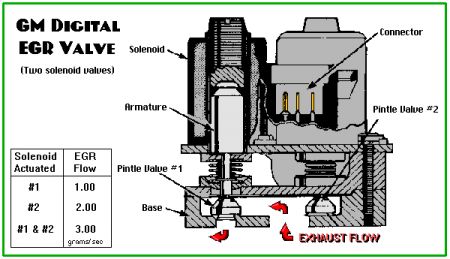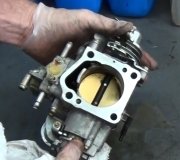EGR TROUBLESHOOTING PROCEDURE
The following "generic" procedure may help you troubleshoot EGR problems.
1. Does the engine have a detonation (spark knock) problem when accelerating under load? Refer to the timing specs for the engine and check ignition timing. The timing may be overadvanced. If the timing is within specs, check the engine's operating temperature. A cooling problem may be causing the engine to detonate. If the temperature is within its normal range and there are no apparent cooling problems, other possibilities to investigate include a spark plugs that are too hot for the engine application, a lean air/fuel mixture, low octane fuel or too much compression (due to a buildup of carbon in the combustion chambers or because of pistons or heads that have too much compression for the fuel you're using). Be sure you've ruled out all the other possibilities before focusing on the EGR system.
2. Use a vacuum gauge to check the EGR valve vacuum supply hose for vacuum at 2000-2500 rpm. There should be vacuum if the engine is at normal operating temperature. No vacuum would indicate a problem such as a loose or misrouted hose, a blocked or inoperative ported vacuum switch or solenoid, or a faulty vacuum amplifier (or vacuum pump in the case of a diesel engine).
Sometimes loss of EGR can be caused by a failed vacuum solenoid in the EGR's vacuum supply line. Refer to a vacuum hose routing diagram in a service manual or the hose routing information on the vehicle's emission decal for the location of the solenoid. If the solenoid fails to open when energized, jams shut or open, or fails to function because of a corroded electrical connection, loose wire, bad ground, or other electrical problem, it will obviously affect the operation of the EGR valve. Depending on the nature of the problem, the engine may have no EGR, EGR all the time, or insufficient EGR. If bypassing the suspicious solenoid with a section of vacuum tubing causes the EGR valve to operate, find out why the solenoid isn't responding before you replace it. The problem may be nothing more than a loose or corroded wiring connector.
3. Inspect the EGR valve itself. Because of the valve's location, it may be difficult to see whether or not the valve stem moves when the engine is revved to 1500 to 2000 rpm by slowing opening and closing the throttle. The EGR valve stem should move if the valve is functioning correctly. A hand mirror may make it easier to watch the valve stem. Be careful not to touch the valve because it will be hot! If the valve stem doesn't move when the engine is revved (and the valve is receiving vacuum), there's probably something wrong with the EGR valve.
Another way to "test" the EGR valve on some engines is to apply vacuum directly to the EGR valve. Note; This only works on ported vacuum EGR valves, not backpressure EGR valves or electronic EGR valves. Vacuum should pull the valve open creating the equivalent of a large vacuum leak. This should cause a momentary drop in idle speed and a noticeable increase in idle roughness.
Backpressure type EGR valves are more difficult to check because there must be sufficient backpressure in the exhaust before the valve will open when vacuum is applied. One trick that's sometimes used is to create an artificial restriction by inserting a large socket into the tailpipe, then applying vacuum to the valve to see if it opens. Don't forget to remove the restriction afterwards.
4. Remove and inspect the EGR valve if you suspect a problem. Most failures are caused by a rupture or leak in the valve diaphragm. If the valve is not a backpressure type, it should hold vacuum when vacuum is applied with a hand-help pump. If it can't hold vacuum, it needs to be replaced. Note: This test does not work on backpressure EGR valves.
Backpressure EGR valves sometimes fail if the hollow valve stem becomes clogged with carbon or debris. This you can see for yourself. It's almost impossible to remove such a clog, so replace the EGR valve.
Carbon accumulations around the base of the EGR valve can sometimes interfere with the opening or closing of the valve. These can be removed by careful brushing or by soaking the tip of the valve in solvent. Do not soak the entire valve in solvent or allow solvent to get anywhere near the diaphragm. The solvent will attack and ruin the diaphragm.
5. Inspect the EGR passageway in the manifold for clogging. Use a pipe cleaner or small piece of wire to explore the opening for a blockage. Sometimes you can dislodge material that's clogging the opening by carefully poking at it. Other times, it may be necessary to remove the manifold and have it professionally cleaned

Thursday, August 7th, 2008 AT 12:09 AM




